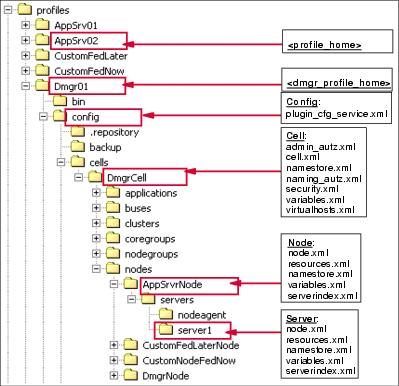2.4.1 Repository directory structure
With V6.x, the directory structure of a WAS installation is slightly different than in previous releases. We will discuss this in detail in Chapter 3, Getting started with profiles, but for now, it is important to know configuration files defining a run time environment are stored in profile directories. Each node, deployment manager, and stand-alone appserver has its own profile directory under the <was_home>/profiles directory.
|
In the rest of this book, when we talk about a specific profile directory, located at, <was_home>/profiles/<profile>, we will refer to it as the <profile_home> directory.
When we are speaking specifically of the profile directory for the deployment manager, we will refer to it as <dmgr_profile_home>.
|
The repository files are arranged in a set of cascading directories under each profile directory structure, with each directory containing a number of files relating to different components of the cell. You can see this in Figure 2-10. The repository structure follows the same format, regardless of whether you have a stand-alone server environment or distributed server environment.

Figure 2-10 Repository directory structure
The <profile_home>/config directory is the root of the repository for each profile. It contains the following directory structure:
This is the root level of the configuration for the cell. The directory contains a number of cell-level configuration files. Depending on the types of resources configured, you might see the following subdirectories:
|
 cells/<cell>/applications/ contains one subdirectory for every application that has been deployed within the cell.
cells/<cell>/applications/ contains one subdirectory for every application that has been deployed within the cell.
|
|
 cells/<cell>/coregroups/ contains one directory for each core group defined.
cells/<cell>/coregroups/ contains one directory for each core group defined.
|
|
 cells/<cell>/nodegroups/ contains one directory for each node group defined.
cells/<cell>/nodegroups/ contains one directory for each node group defined.
|
|
 cells/<cell>/nodes/ contains the configuration settings for all nodes and servers managed as part of this cell. The directory contains one directory per node. Each cells/<cell>/nodes/<node> directory will contain node-specific configuration files and a server directory which in turn will contain one directory per server and node agent on that node.
cells/<cell>/nodes/ contains the configuration settings for all nodes and servers managed as part of this cell. The directory contains one directory per node. Each cells/<cell>/nodes/<node> directory will contain node-specific configuration files and a server directory which in turn will contain one directory per server and node agent on that node.
|
|
 cells/<cell>/clusters/ contains one directory for each of the clusters managed as part of this cell. Each cluster directory contains a single file, cluster.xml, which defines the appservers of one or more nodes that are members of the cluster.
cells/<cell>/clusters/ contains one directory for each of the clusters managed as part of this cell. Each cluster directory contains a single file, cluster.xml, which defines the appservers of one or more nodes that are members of the cluster.
|
The overall structure of the master repository is the same for both a stand-alone server environment and a distributed server environment. The differences are summarized in the following sections.
In a stand-alone server environment, the structure has the following:
| -
| The master repository is held on a single machine. There are no copies of this specific repository on any other node.
|
| -
| The repository contains a single cell and node.
|
| -
| There is no node agent because each appserver is stand-alone, so there is no directory for the node agent (nodeagent).
|
| -
| Clusters are not supported, and therefore will not contain the clusters directory or subdirectories.
|
In a distributed server environment, the structure has the following characteristics:
| -
| The master repository is held on the node containing the deployment manager. It contains the master copies of the configuration and application data files for all nodes and servers in the cell.
|
| -
| Each node also has a local copy of the configuration and application data files from the master repository that are relevant to the node.
|
| -
| Changes can be made to the configuration files on a node, but the changes will be temporary. Such changes will be overwritten by the next file synchronization from the deployment manager. Permanent changes to the configuration require changes to the file or files in the master repository.
|
Configuration changes made to node repositories are not propagated up to the cell.
| -
| The applications directory of the master repository contains the application data (binaries and deployment descriptors) for all applications deployed in the cell. The local copy of the applications directory on each node will only contain the directories and files for the applications deployed on appservers within that node.
|
Information about the individual files found in each of these directories can be found in the Configuration Document Descriptions topic in the Information Center.
| 

 cells/<cell>/applications/ contains one subdirectory for every application that has been deployed within the cell.
cells/<cell>/applications/ contains one subdirectory for every application that has been deployed within the cell.
